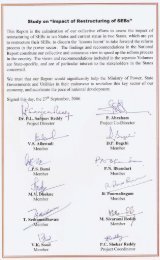Inside Pages9Final.indd - Ministry of Power
Inside Pages9Final.indd - Ministry of Power
Inside Pages9Final.indd - Ministry of Power
You also want an ePaper? Increase the reach of your titles
YUMPU automatically turns print PDFs into web optimized ePapers that Google loves.
Energy-Environment Harmony, Strengthening the<br />
<strong>Power</strong> Delivery Infrastructure, Enabling Digital Society<br />
and Managing Global Sustainability will be realized<br />
through this center.<br />
Energy Technologies targets to focus on setting up<br />
Centres <strong>of</strong> Excellence (CoEs) and indigenisation<br />
<strong>of</strong> technologies. Developing technologies through<br />
collaborative research with best <strong>of</strong> the R&D and<br />
academic institutions in India and subsequently it will<br />
be extended to other global leading institutions. The<br />
institutions where collaborative research work is being<br />
conducted are National Chemical Laboratory (NCL)<br />
Pune, Agharkar Research Institute (ARI) Pune, IIT<br />
Mumbai, University Institute <strong>of</strong> Chemical Technology<br />
(UICT) Mumbai, Central Salt & Marine Chemicals<br />
Research Institute (CSMCRI) Bhavnagar and National<br />
Environmental Engineering Research Institute<br />
(NEERI) Nagpur. The research areas include Artificial<br />
Neural Network based optimization, Computational<br />
Fluid Dynamics (CFD) modeling <strong>of</strong> boiler and cooling<br />
tower, Multi-composition Ammonia Liquor Absorption<br />
Engine (MALAE) cycle, Carbon Sequestration etc.<br />
Under this collaborative arrangement total 12 projects<br />
are identified to be completed in a time span <strong>of</strong> 18<br />
to 48 months. Further, India along with 12 other<br />
countries (now 21) is a founder member <strong>of</strong> “Carbon<br />
sequestration Leadership forum” (CSLF).<br />
Around 75 Acres <strong>of</strong> land has been acquired at Greater<br />
Noida for the construction <strong>of</strong> ET Building.<br />
15.0 TECHNOLOGY ABSORPTION : Capacity addition <strong>of</strong><br />
over 1,50,000 MW is envisaged in the country during<br />
the XI and XII Plan periods. More than two third <strong>of</strong><br />
this capacity addition is expected from thermal power<br />
stations. Amongst several factors affecting pace <strong>of</strong><br />
capacity addition, unit size is considered to be very<br />
important. With this in view, adopting higher unit sizes<br />
in the country was considered for accelerating pace<br />
<strong>of</strong> capacity addition as required. The first beginning in<br />
this regard has already been made by NTPC by going<br />
in for 660 MW size units in Sipat-l and Barh projects to<br />
be followed by North Karanpura.<br />
However, to decide on still higher size <strong>of</strong> thermal units,<br />
NTPC has examined the following aspects :<br />
• Technologies available worldwide, their maturity<br />
levels and availability <strong>of</strong> technologies for adoption in<br />
India.<br />
MINISTRY OF POWER<br />
• Status <strong>of</strong> technology availability with BHEL for<br />
implementation in Indian context.<br />
• Strategy for induction <strong>of</strong> higher size units in<br />
association with BHEL including transfer <strong>of</strong><br />
technology.<br />
• Efficiency and other benefits, likely project<br />
cost, techno-economic analysis vis-a-vis other<br />
options.<br />
NTPC is <strong>of</strong> the opinion that 800 MW unit size which<br />
is considered to be an ultimate size for Indian coal<br />
can be adopted. However, International Consultant’s<br />
assistance would be required in technology scan,<br />
carrying out the basic engineering including<br />
preparation <strong>of</strong> RDM, Techno-economics and<br />
finalization <strong>of</strong> the steam parameters, equipment<br />
sizing, interface parameters and review <strong>of</strong> technical<br />
specifications.<br />
16.0 ENVIRONMENT MANAGEMENT : NTPC with the<br />
goal <strong>of</strong> achieving sustainable development <strong>of</strong> the<br />
power sector in the country has taken a number<br />
<strong>of</strong> dedicated and growth oriented measures for<br />
Environment Management in its various business<br />
units. It is actively pursuing the Charter on Corporate<br />
Responsibility for Environmental Protection (CREP)<br />
released by <strong>Ministry</strong> <strong>of</strong> Environment and Forests for<br />
various industries including Thermal <strong>Power</strong> Plants.<br />
A number <strong>of</strong> measures have been taken for further<br />
improving performance <strong>of</strong> stations especially in the<br />
areas <strong>of</strong> stack emissions and effluents discharged.<br />
To further enhance the performance <strong>of</strong> Electro<br />
Static Precipitators (ESPs) in order to maintain stack<br />
particulate emissions within the stipulated limits on<br />
sustained basis, trial study is being conducted in one<br />
Unit at NTPC - Farakka by conditioning flue gas with<br />
Ammonia. Its long-term effects are being studied in<br />
the Unit for evaluating the efficacy <strong>of</strong> the technology<br />
to maintain low emissions in the Indian context.<br />
As a proactive measure, in a number <strong>of</strong> stations<br />
recycling/reuse systems have been installed and<br />
commissioned to conserve water. Ash Water<br />
recycling system has been installed & commissioned<br />
at Ramagundam, Simhadri, Rihand, Talcher Kaniha,<br />
Talcher Thermal, Kahalgaon, Korba and Vindhyachal.<br />
Also, Effluent Treatment Plant (ETP) has been installed<br />
& commissioned at Ramagundam, Kahalgaon,<br />
89

















